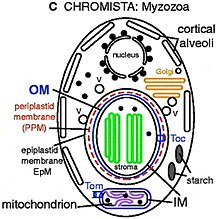| Myzozoa | |
|---|---|

| |
| Myzozoa membrane structure | |
| Scientific classification | |
| Domain: | Eukaryota |
| Clade: | Diaphoretickes |
| Clade: | SAR |
| Clade: | Alveolata |
| Phylum: | Myzozoa Cavalier-Smith & Chao |
| Phyla | |
Myzozoa is a grouping of specific phyla within Alveolata, that either feed through myzocytosis, or were ancestrally capable of feeding through myzocytosis.
Many protist orders are included within Myzozoa.
It is sometimes described as a phylum, containing the major subphyla Dinozoa and Apicomplexa, plus minor subphyla.
The term Myzozoa superseded the previous term "Miozoa", by the same authority, and gave a slightly altered meaning.
Phyla
Within Myzozoa, there are around four phyla:
- Apicomplexa – parasitic protozoa that lack axonemal locomotive structures except in gametes
- Dinoflagellates – mostly marine flagellates many of which have chloroplasts
- Chromerida – a marine phylum of photosynthetic protozoa
- Perkinsozoa
The term/group Myzozoa was not considered in a resolution of protist groups by Adl et al. 2012. Strict taxonomy only considers common traits possessed by all organisms of the group. Some organisms within each of the component groups of Myzozoa have lost the ability for Myzocytosis. Further, as taxonomy pays no account of molecular phylogeny, one current classification has all alveolate taxa other than apicomplexans, ciliates and dinoflagellates, named under the grab bag term "Protalveolata". The difficulty of placing very early dinozoans either within or outside the group "dinoflagellates" continues to favour classifications such as Protalveolata, as does the potential polyphyly between the two genera of "colpodellids" Voromonas and Colpodella.
Evolution
The most closely related large clade to the myzozoans are the ciliates. Both of these groups of organisms – unlike the majority of eukaryotes studied to date – seem to have a linear mitochondrial genome. Most other eukaryotes that have had their mitochondrial genomes examined have circular genomes. However, the taxonomic term Myzozoa specifically excludes ciliates which are rather under the higher taxonomic rank Alveolata. Thus, Alveoata includes two large groups: Myzozoa and Ciliophora plus the smaller groups discussed above.
All Myzozoa appears to have evolved from an ancestor that possessed plastids, required through endosymbiosis.
The branching order within both Myzozoa and Protalveolata, is only partly understood. Three groups – the Colpodellids, Chromerida and the Apicomplexa – appear to be sister clades. Three other groups – the Perkinsids, Syndiniales and Oxyrrhis are distantly related to the dinoflagellates.
Notes
Perkinsus marinus and the Apicomplexa both have histones while the dinoflagellates appear to have lost theirs.
Chromerida are ancestrally myzocytotic, on the basis of evidence for myzocytosis by the chromerid Vitrella brassicaformis.
References
- ^ Cavalier-Smith, T.; Chao, E.E. (2004). "Protalveolate phylogeny and systematics and the origins of Sporozoa and dinoflagellates (phylum Myzozoa nom. Nov.)". European Journal of Protistology. 40 (3): 185–212. doi:10.1016/j.ejop.2004.01.002.
- Leander BS, Hoppenrath M (February 2008). "Ultrastructure of a novel tube-forming, intracellular parasite of dinoflagellates: Parvilucifera prorocentri sp. nov. (Alveolata, Myzozoa)". Eur. J. Protistol. 44 (1): 55–70. doi:10.1016/j.ejop.2007.08.004. PMID 17936600.
- "Alveolates". Retrieved 2009-06-14.
- Valster RM, Wullings BA, Bakker G, Smidt H, van der Kooij D (May 2009). "Free-living protozoa in two unchlorinated drinking water supplies identified by phylogenic analysis of 18S rRNA gene sequences". Appl. Environ. Microbiol. 75 (14): 4736–46. doi:10.1128/AEM.02629-08. PMC 2708415. PMID 19465529.
- Cavalier-Smith T (June 2004). "Only six kingdoms of life". Proc. Biol. Sci. 271 (1545): 1251–62. doi:10.1098/rspb.2004.2705. PMC 1691724. PMID 15306349.
- ^ Cavalier-Smith T, Chao EE (September 2004). "Protalveolate phylogeny and systematics and the origins of Sporozoa and dinoflagellates (phylum Myzozoa nom. nov.)". Eur J Protistol. 40 (3): 185–212. doi:10.1016/j.ejop.2004.01.002.
- ^ Adl SM, Simpson AG, Lane CE, Lukeš J, Bass D, Bowser SS, Brown MW, Burki F, Dunthorn M, Hampl V, Heiss A, Hoppenrath M, Lara E, Le Gall L, Lynn DH, McManus H, Mitchell EA, Mozley-Stanridge SE, Parfrey LW, Pawlowski J, Rueckert S, Shadwick RS, Shadwick L, Schoch CL, Smirnov A, Spiegel FW (2012). "The revised classification of eukaryotes". J. Eukaryot. Microbiol. 59 (5): 429–93. doi:10.1111/j.1550-7408.2012.00644.x. PMC 3483872. PMID 23020233.
- "Protalveolata – Wikispecies".
- Muñoz-Gómez, Sergio A.; Slamovits, Claudio H. (2018). "Plastid Genomes in the Myzozoa". Plastid Genome Evolution. Advances in Botanical Research. Vol. 85. pp. 55–94. doi:10.1016/bs.abr.2017.11.015. ISBN 9780128134573.
- Moore RB, Oborník M, Janouskovec J, et al. (February 2008). "A photosynthetic alveolate closely related to apicomplexan parasites". Nature. 451 (7181): 959–63. Bibcode:2008Natur.451..959M. doi:10.1038/nature06635. PMID 18288187.
- Saldarriaga, J. F.; McEwan, M. L.; Fast, N. M.; Taylor, F. J.; Keeling, P. J. (2003). "Multiple protein phylogenies show that Oxyrrhis marina and Perkinsus marinus are early branches of the dinoflagellate lineage". International Journal of Systematic and Evolutionary Microbiology. 53 (Pt 1): 355–365. doi:10.1099/ijs.0.02328-0. PMID 12656195.
- Leander BS, Kuvardina ON, Aleshin VV, Mylnikov AP, Keeling PJ (2003). "Molecular phylogeny and surface morphology of Colpodella edax (Alveolata): insights into the phagotrophic ancestry of apicomplexans". J. Eukaryot. Microbiol. 50 (5): 334–40. doi:10.1111/j.1550-7408.2003.tb00145.x. PMID 14563171.
- Gornik SG, Ford KL, Mulhern TD, Bacic A, McFadden GI, Waller RF (December 2012). "Loss of nucleosomal DNA condensation coincides with appearance of a novel nuclear protein in dinoflagellates". Curr. Biol. 22 (24): 2303–12. doi:10.1016/j.cub.2012.10.036. PMID 23159597.
- Molecular ecology and phylogeny of protistan algal symbionts from corals (Thesis). 2006.
| Eukaryote classification | |||||||||||||||||||||||||||||||||||||||||||||||||||
|---|---|---|---|---|---|---|---|---|---|---|---|---|---|---|---|---|---|---|---|---|---|---|---|---|---|---|---|---|---|---|---|---|---|---|---|---|---|---|---|---|---|---|---|---|---|---|---|---|---|---|---|
| |||||||||||||||||||||||||||||||||||||||||||||||||||
| |||||||||||||||||||||||||||||||||||||||||||||||||||
| |||||||||||||||||||||||||||||||||||||||||||||||||||
| Incertae sedis |
| ||||||||||||||||||||||||||||||||||||||||||||||||||
| |||||||||||||||||||||||||||||||||||||||||||||||||||
| Taxon identifiers | |
|---|---|
| Myzozoa | |
| Miozoa | |